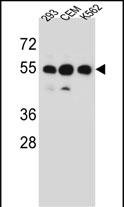
| WB | 1/1000 | Human,Mouse,Rat |
| IF | 咨询技术 | Human,Mouse,Rat |
| IHC | 咨询技术 | Human,Mouse,Rat |
| ICC | 技术咨询 | Human,Mouse,Rat |
| FCM | 咨询技术 | Human,Mouse,Rat |
| Elisa | 咨询技术 | Human,Mouse,Rat |
| Aliases | Zinc finger protein 562, ZNF562 |
| Entrez GeneID | 54811 |
| WB Predicted band size | 48.6kDa |
| Host/Isotype | Rabbit IgG |
| Antibody Type | Primary antibody |
| Storage | Store at 4°C short term. Aliquot and store at -20°C long term. Avoid freeze/thaw cycles. |
| Species Reactivity | Human |
| Immunogen | This ZNF562 antibody is generated from rabbits immunized with a KLH conjugated synthetic peptide between 4-33 amino acids from the N-terminal region of human ZNF562. |
| Formulation | Purified antibody in PBS with 0.05% sodium azide. |
+ +
The ZNF562 (N-term) antibody is designed to target the N-terminal region of zinc finger protein 562 (ZNF562), a member of the zinc finger protein family characterized by conserved C2H2-type zinc finger domains involved in DNA binding and transcriptional regulation. ZNF562 is thought to play roles in cellular processes such as proliferation, differentiation, and chromatin remodeling, though its precise biological functions remain under investigation. The antibody is commonly used in research applications like Western blotting, immunofluorescence, and chromatin immunoprecipitation (ChIP) to study ZNF562's expression, localization, and interactions.
As an N-terminal-specific antibody, it recognizes epitopes within the protein's initial segment, which may include regulatory or functional domains critical for its activity. Host species (e.g., rabbit, mouse) and clonality (monoclonal or polyclonal) vary by commercial source, but validation typically includes reactivity confirmation in human, mouse, or rat samples. Studies using this antibody may explore ZNF562's potential links to diseases, such as cancer or neurological disorders, where zinc finger proteins often contribute to pathogenesis via dysregulated gene expression. Researchers should verify batch-specific validation data, including knockdown/knockout controls, to ensure specificity. Overall, this tool aids in elucidating ZNF562's role in gene regulation and disease mechanisms.
×